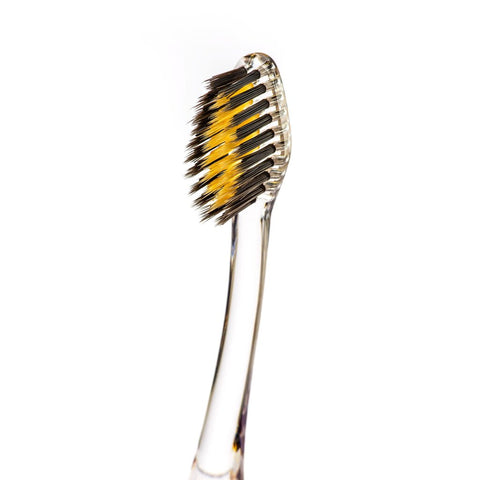Bacteria are everywhere. We must acknowledge the fact we share this world with billions of tiny creatures. There is no getting rid of them, and most of the time we really shouldn't. Because it helps us live our lives the way we know it. Our digestive systems and our eyes depend on it, as many other vital functions of our bodies. But there are also harmful bacteria that make us sick. It comes not so much from the expected places, but from the ones, we think to be safe. Catching a virus in the public transportation is pretty common, but have you ever thought about what kind of bacteria is harboured in your toothbrush?
Where Do Bacteria Come From?

It’s difficult for us humans to digest the fact that an essential tool in our hygiene, that we literally put in our mouth can be so disgusting. But the truth is that toothbrushes may play a huge role in disease transmission and increase the risk of infection. Contamination of toothbrushes, as serious as it sounds, occurs right after the first brushing and it worsens with time. More than 10 million bacteria can be found on an average brush. It comes from the oral cavity, the moist environment, the storage containers and even the toilet. For instance, every time you flush the toilet particles are being spread in a radius of 6 feet if you forget to close the lid. It’s not pretty.
Connection Between Oral and Overall Health
People tend to underestimate dental health at the expense of overall medical health. But in reality, what happens in the mouth affects the whole body.
Imagine all these infectious microorganisms sticking on your toothbrush, multiplying and surviving there. They find their way to attack your immune system and cause a disease.
The scientific explanation оf disease transmission is that each tooth is surrounded by a tight girdle of fibres that pulls the gums closely around its neck. The purpose of this strong seal is to block the entry of elements. If they get into the immune system through the mouth tissues, an infection might occur. Important is that the path between bacteria in the mouth and the bloodstream is closed. That’s why the seal should be tight enough to stop elements from the outside environment from rushing into the bloodstream.
Analogically, tearing the surface of the skin allows pathogenic microorganisms to infect all other systems.
Potential Diseases
When using your toothbrush for a long period of time, microorganisms such as Pseudomonas, Candida, Streptococcus, Lactobacilli etc., easily contaminate the oral cavity. The latter is known for causing dental caries, gingivitis, stomatitis and other disorders concerning your dental health. In addition, studies have demonstrated the possibility of these bacteria transmitting health problems like heart disease (infective endocarditis), arthritis, bacteremia, and stroke. Other potential conditions that oral infections might engender or complicate are diabetes, bacterial pneumonia, dementia, prostate cancer, etc. The affection of both oral and general health proves the thesis about the connection between them.
Wrong Decontamination Methods
In order to avoid those critical for your health illnesses, it’s important to maintain your toothbrush. For that reason, we will present you the variety of disinfection options and their effects.
- Dishwashing/microwaving the toothbrush
People often try to clean their oral hygiene appliances by dishwashing them or putting them in a microwave. Indeed, this technique destroys germs, but there’s a good chance for the plastic part and the bristles to be harmed which would lessen their effectiveness.
- Soaking it in mouthwash/disinfectant
According to the Centers for Disease Control and Prevention (CDC) soaking your toothbrush in mouthwash or a disinfectant can lead to cross-contamination when using the same one for a prolonged period or sharing the product with another user. The American Dental Association (ADA) also adds that the effect of this method has not been proved yet.
- Using UV sanitizers
Among the most common methods for disinfection of a toothbrush is the ultraviolet (UV) light. It is claimed that UV sanitizers eliminate almost all of the germs on your toothbrush with the help of UV light. Now just stop and think about going on a holiday and having to bring the whole device with you. From this point of view, the most considerable disadvantage of UV sanitizers is their inconvenience. They are simply hard to carry around.
Tips for Proper Decontamination

The moist environment is a perfect precondition for bacterial growth. Use a container when you travel to avoid dirt and germs on your toothbrush, but don’t forget to put it dry in the package. Clean the container regularly with your own mouthwash as the chlorhexidine found in it represented a good antibacterial substance.
As already mentioned, faecal matter coming from the toilet may stick to the bristles and cause unwanted health problems.
Especially if it is a cup. This measure is conditioned by the excessive growth of bacteria in the amount of water at the bottom, which can be transmitted to the brush that you put in your mouth.
If you do this, bodily fluids and germs mix, which might cause an infection.
Or sooner if you notice that the bristles have become frayed with use. Otherwise, the cleaning efficiency will have decreased, and that will make your efforts for oral hygiene senseless.
Antibacterial toothbrushes are a simple solution to this complicated problem. They don’t require extra care and there are no unnecessary tools.
Why Antibacterial Toothbrushes are the Solution:
Several studies have confirmed that gold and silver nanoparticles have antibacterial properties.
One of them investigated the effects of the elements gold and silver on bacteria Bacillus Calmette-Guérin and Escherichia coli. The former causes tuberculosis and the latter, known as E. coli, comes from faecal matter if you brush your teeth in a bathroom with a toilet, claims Business Insider. The results suggested that nanoparticles represent useful candidates for therapeutics and possess excellent antibacterial properties.
Another scientific report has documented that silver not only plays an essential role as an antimicrobial agent against diseases, but it also shows prolonged activity due to the slow-release of its biocidal cations and prevents bacterial re-colonization and contamination of wounds and biomedical devices.
Nano-b is Clinically Proven to Destroy 99.9% of Harmful Bacteria
We created a toothbrush that uses exactly these natural resources to impregnate the bristles of our toothbrushes with. Both gold and silver safeguard your Nano-b toothbrush from bacteria, which keeps it cleaner and safer. The Nano-b toothbrush is clinically proven by KIFA to destroy 99.9% of harmful bacteria. Each brush is infused with gold or silver nanoparticles that manage to sterilize over 650 types of bacteria and viruses, including E. Coli, Streptococcus and Salmonella.
Where can I buy it from?
You can buy The Nano-b Toothbrush from our Shop. We ship worldwide, but if you don’t see your country - write to us and we will fix the problem. Be sure to subscribe to our newsletter to receive exclusive promotions and more helpful content on oral health.




Comments (0)
There are no comments for this article. Be the first one to leave a message!